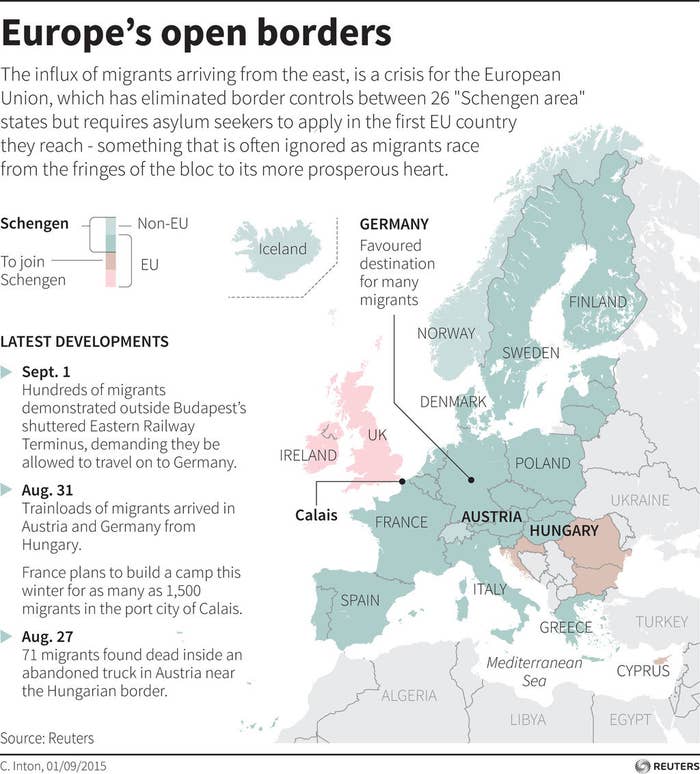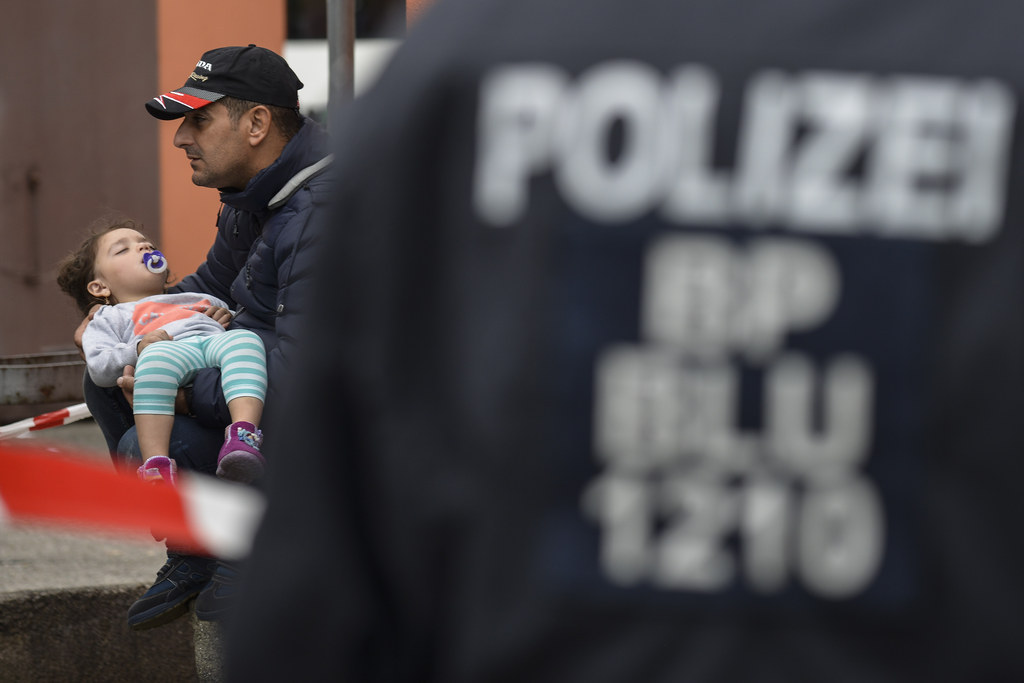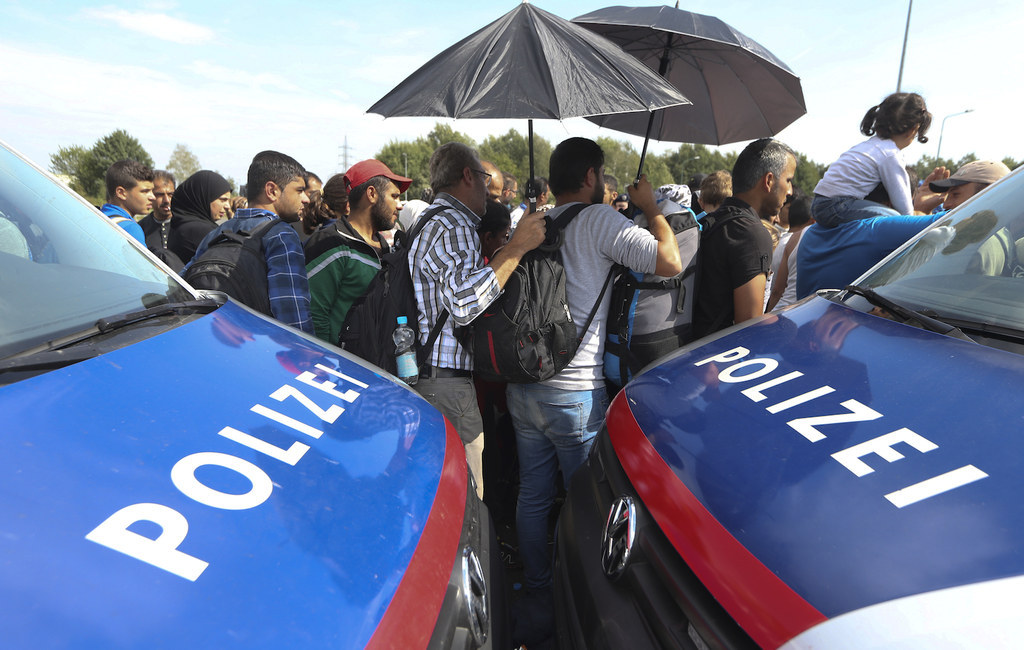The growing number of refugees flowing into Europe has placed enormous pressure on governments across the continent and challenged one of the main tenets of the European Union: the free movement of people.

In recent weeks, European authorities have struggled to deal with the sheer numbers of people making their way into and across Europe from conflict zones. As a result, the borderless Schengen Area — where internal borders between 26 participating EU nations are replaced with one unifying external frontier — has been temporarily compromised at numerous points over the last few days as governments have opted to close off routes in from neighboring countries.
This Reuters graphic, created earlier this month, shows which EU countries fall in the Schengen zone.

The Schengen Agreement — named after the Luxembourg town in which it was signed — first came into operation in 1995, when seven of the then–15 EU member states dismantled border controls and allowed people to pass through without a passport.
It was one of the first steps towards the vision of a more integrated Europe, which also led to the implementation of the single currency. At the time, Germany's then–Foreign Minister, Klaus Kinkel, said it marked the "precursor to complete freedom of movement in all of Europe," according to the New York Times.
Twenty years later, the refugee crisis and Europe's response to it are posing a big threat to this integrationist ideal.
Here is how Schengen countries have temporarily suspended — or at least considered suspending — their participation in the agreement over the last few days.
GERMANY

Germany temporarily reintroduced passport controls on its border with Austria on Sunday. It was one of the first signifiers that Angela Merkel's government may be hardening its stance on allowing refugees and migrants into the country, and dealt one of the biggest blows to borderless travel within the EU in the two decades it has been operational.
On Sunday, German Interior Minister Thomas de Maiziere said, "The aim of these measures is to limit the current inflows to Germany and to return to orderly procedures when people enter the country," Deutsche Welle reported.
Germany's rail operator Deutsche Bahn announced Sunday that it had suspended cross-border services from Salzburg, Austria, to Munich for 12 hours on the advice of the federal government amid reports of people on the lines.
On Monday, Deutsche Welle reported heavy traffic on the main road into Germany from Salzburg as a result of the border checks, with queues up to 20 kilometers (12 miles) long, according to AP.
The decision was taken without consulting Vienna, Brussels, or Budapest, and many have taken the move as a sign of the German government's growing frustration at the unwillingness of the rest of the EU to share the burden of taking in refugees.
The German government insisted refugees were still welcome into the country Monday and said the border measures would ensure they arrive in an orderly fashion, AP reported.
A government spokesperson also insisted that "temporary border controls are not a closure of the border."
The move led some EU politicians to question whether Schengen could survive the crisis.
By shutting border with Austria, is clear that German government have realised the scale of their error. Schengen surely can't survive now.
Last Wednesday, the Danish government put restrictions on rail, road, and ferry crossings from Germany as a response to growing numbers of refugees passing through to Sweden.
RT @joerg_jacobsen No border control from both sides (neither #Germany nor #Denmark) #refugeeswelcome https://t.co/dIb3ZL9Mkd
However, eyewitnesses on the German-Danish border reported that traffic was moving freely Monday.
AUSTRIA

On Monday, Austria strengthened checks on its borders with Hungary and Slovakia in direct response to Berlin's move, increasing spot checks and deploying 2,200 soldiers to help police deal with refugees arriving.
Speaking at a news conference in Vienna, Austrian Vice Chancellor Reinhold Mitterlehner said, "If Germany does border controls, then Austria must also strengthen border controls — in the interest of the domestic population — and we are doing this now. This will also be a clear signal in the direction of those affected that the disorderly crossing of the border can no longer take place in the future," the Wall Street Journal reported.
The checks also caused heavy traffic jam at the Austro-Hungarian border.
Traffic at a standstill at borders between Austria and Hungary, Austria and Germany - as seen on Google Maps
SLOVAKIA
Slovakia says introducing temporary border controls with Hungary and Austria - although not clear what that involves beyond spit checks.
The domino effect from Germany's shock move also caused the Slovakian government to take action.
The country's Interior Ministry announced it was introducing temporary border controls Monday and deploying 200 more officers to deal with any incoming refugees, the Daily Telegraph reported.
POLAND
When I warned about this two weeks ago, people laughed. Still funny? @zelazna_logika
The restrictions placed on Austria's border have caused some alarm for the Polish government.
On Monday, Polish Prime Minister Ewa Kopacz told the European Union's Jean-Claude Juncker that the country would not accept automatic quotas for refugees and would begin controlling its borders if the government deemed it necessary, ITV News reported:
As soon as I receive (any) notification of any threat (to border security), Poland will start controlling its borders.
We will accept only as many refugees as we can afford, not a single one more or less.
CZECH REPUBLIC
Czech official told me their border strengthening is to stop migrants going Austria-CZ-Germany. Poland next in line. Schengen teetering...
On Sunday, the Czech government said it would also adopt the measures taken by Germany.
Speaking on Czech Television, Interior Minister Milan Chovanec said: "The Czech Republic is boosting measures on its border with Austria. Further steps will be determined according to the number of refugees heading to the Czech Republic."
He added that Germany's decision to reintroduce border controls with Austria meant the Czech Republic is "now the only bypass" for refugees, and said the Czech government is "doing its best to send a clear signal that we will observe the European law on our borders ... and boost the performance of our people on the border so that we would be able to return migrants to the neighboring country," AFP reported.
HUNGARY
The knock-on effect of Germany's border restrictions on Sunday coincided with the completion of Hungary's border fence with Serbia — the outer frontier of the Schengen zone — on Monday afternoon.
Hungarian authorities have long been criticized by rights group for what some see as its heavy-handed treatment of refugees at the border, and the controversial building of a razor-wire fence aimed at keeping refugees and migrants out of the country.
The new border line of Europe, courtesy of Hungary. Refugees walk along the fence.
2km down is the official border crossing. Refugees are queuing but so far no one coming thru
Hungary's closure of its border with Serbia means that refugees and migrants are not able to travel along their previously established route into the Schengen zone, and could mean that those fleeing conflict face newer and bigger challenges.
Someone tweeted this will be the new refugee route if Hungary succeeds in closing border. More dangerous apparently
@drquirkey @owebb Compare the new route to this 2008 map of landmines in Bosnia, via https://t.co/rEc23tsM6B
